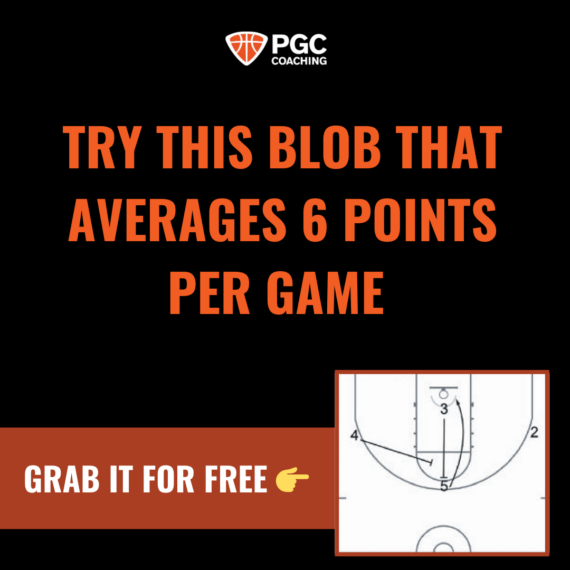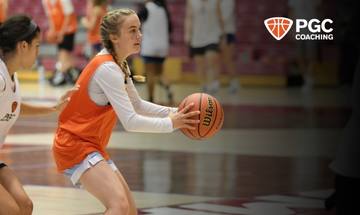2-on-2 Entry Passing Drill: Mastering Ball Pressure and Clean Entry Passes
An extended defense that denies the first pass can be a point guard’s worst nightmare… if they’re not prepared for it.
That’s where our 2-on-2 Entry Passing Drill comes in. This basketball passing drill prepares your guards and wings to execute when the game speeds up and the pressure tightens.
But before we dive in, here are a few more passing drills you may want to check out after you look at the 2-on-2 entry basketball passing drill:
- Serbian Passing Drill: Teach Your Players to Pass at Full Speed
- Wrap Passing Drill: Build Footwork, First-Step Quickness & Precision Passing
- Train the “One Extra” Pass: A Simple Drill to Build Unselfish Teams
Why This Basketball Passing Drill Matters
As a former point guard, I believe this is one of the toughest actions in the game—dribbling up under pressure and delivering an accurate entry pass to a wing who’s being denied. And it’s often overlooked in practice.
But if you don’t drill it, you can’t expect your players to succeed in the heat of the moment.
This basketball passing drill forces players to:
- Navigate and pass under intense pressure
- Use space and timing to make backdoor reads
- Learn how and when to pop out or cut
- Compete with purpose (first team to 5 wins)
How the Drill Works
Split the court in half so both sides can go at once. You’ll have two players up top: one ball-handler and one defender. On the wing, another pair: one receiver and one defender.
- The offensive player on the wing must work to get open against a denial.
- The ball-handler must control their defender and attempt to deliver an entry pass.
- If the pass is completed and the receiver squares up powerfully, it’s a point.
- If denied, the receiver can backdoor cut for a layup (also worth a point).
- If the dribbler beats their defender to the paint and jump-stops under control, that’s another way to score.
Add Pressure & Limitations
To sharpen skill development:
- Restrict space using cones or designated areas.
- Set limits like “only one backdoor per five-point game.”
- Add a rule that a pass or drive must be made before crossing the lane.
These constraints force players to make better reads and communicate under pressure.
Why We Love It
This basketball passing drill combines decision-making, communication, footwork, and toughness—all within a simple, competitive format.
You’ll help your players learn:
- How to control a defender with the dribble
- When to deliver the entry pass
- How to read spacing and defender positioning
And maybe most importantly—you’ll help them build the poise to handle pressure, which carries over into everything else they do.
2 on 2 Entry Passing Video Drill for Coaches
FAQ: 2-on-2 Entry Passing Drill for Poise, Timing, and Ball Control Under Pressure
This FAQ helps coaches and players understand how to run the 2-on-2 Entry Passing Drill effectively, why it matters, and how to adapt it for different skill levels and team contexts.
Q: What is the goal of the 2-on-2 Entry Passing Drill?
A: The goal is to simulate game-like ball pressure and teach players how to deliver entry passes under denial defense. It sharpens the passer’s ability to:
- Handle pressure with poise
- Make accurate passes under duress
- Read when to deliver, backdoor, or drive
The receiver works on creating separation and timing cuts—foundational skills often under-practiced.
Use this drill to help guards and wings execute clean entries against aggressive defenses.
Q: Why is this drill important for point guards?
A: Point guards are often tasked with breaking pressure and initiating offense. This drill puts them in the exact scenario they’ll face in games—defense extended, passing angles denied, and quick decisions required. Practicing these reads builds composure, control, and better leadership under pressure.
Run this drill consistently to prepare point guards for real-game pressure situations.
Q: How does scoring work in this drill?
A: Scoring is based on execution:
- 1 point for a successful entry pass + strong square-up
- 1 point for a clean backdoor cut and finish
- 1 point for the dribbler driving under control and jump-stopping in the paint
This format encourages purposeful reps and keeps intensity high.
Keep score during each round to drive competitive focus and learning.
Q: What coaching cues help during this drill?
A: Key coaching points include:
- Ball-handler: stay low, protect the ball, use change of pace, see both defenders
- Receiver: show hands early, use fakes, time your pop-outs or backdoors
- Both players: communicate constantly and read the defender’s feet
This drill is as much about timing and feel as it is about mechanics.
Coach real-time adjustments, not just technique—help players learn to read the defense.
Q: How can I scale this drill for different experience levels?
A: For beginners or youth players:
- Start with no defenders, then introduce light guided defense
- Use shorter distances and simplify rules
For advanced players:
- Add tight space constraints
- Introduce timed decisions (e.g., must pass in 3 seconds)
- Mix in help defense reads
Scaling ensures the drill stays challenging but accessible.
Tailor constraints and intensity to match your team’s developmental stage.
Q: What variations can I use to increase difficulty?
A: You can add:
- Lane-line restrictions using cones
- One backdoor max per round
- Required reversals or fakes before a pass
These variations promote discipline, spacing awareness, and smarter decision-making.
Layer rules to target specific weaknesses or situational challenges your team faces.
Q: How do I keep the drill organized in a busy gym?
A: Split the court in half and run two games simultaneously, one on each side. With just 4 players per half-court, the drill stays active, efficient, and focused. Use short rounds (to 5 points) and rotate groups to keep energy high.
Maximize reps by running mirrored sets and limiting downtime between rounds.
Q: Can this drill help with turnovers in games?
A: Yes. It trains players to protect the ball, anticipate defenders, and pass under pressure—the exact situations where most turnovers occur. Repeated reps build instincts and habits that reduce careless passes and improve execution in tough spots.
Track in-game turnovers pre- and post-drill implementation to measure impact.
Q: How often should I use this drill in practice?
A: Use it 1–2 times weekly, especially during:
- Press break or zone entry segments
- Offensive execution breakdowns
- Practice blocks focused on ball security or pressure reads
It fits seamlessly into any practice plan that emphasizes toughness, timing, and communication.
Schedule regular sessions to reinforce composure and sharp passing under pressure.
Q: Where can I find more passing and pressure-defense drills like this one?
A: You’ll find more competitive passing drills, game breakdowns, and coaching support inside the PGC Coaching Community. With a free 7-day trial, you’ll access resources that focus on decision-making, ball security, and team communication under pressure.
Start your free trial of the PGC Coaching Community to explore more drills that sharpen passing and ball control.
Train Composure and Precision with the 2-on-2 Entry Drill
The best guards don’t just handle pressure—they thrive in it. Use this drill to build those habits, raise your team’s execution level, and instill poise where it matters most.
Mano Watsa
Check out all of our offensive drills and strategy resources here.
About the Author
Mano Watsa
Mano is the visionary leader of PGC Basketball which serves more than 20,000 players and coaches each year through camps, clinics, and online coaching. Mano has coached at nearly every level of play from youth teams to college teams. And he inspires countless coaches each year in the PGC Community and beyond.
New Here?
Get coaching tips and tools like these delivered to your inbox each week!
Join the 15,000 coaches we’ve assisted…

Related Articles
5 Passing Drills to Build Tough, Smart, & Unselfish Basketball Players
Want fewer turnovers and sharper ball movement? These 5 game-ready passing drills will help your players handle pressure, make better reads, and move the ball like a team built to win.
4-on-4 Finishing Game: Train Shot Selection, Spacing & Competitive Intensity
Boost your team’s finishing skills with our 4-on-4 drill! Build shot discipline, smart decisions, and strong finishes under real-game pressure. Perfect for game-ready players.
Comfort in Chaos: Train Game-Ready Finishing Under Pressure
Help your players finish strong in chaos. The Comfort in Chaos drill builds confidence and composure under pressure for game-ready scoring.
About PGC
PGC Basketball provides intense, no-nonsense basketball training for players and coaches. Our basketball camps are designed to teach players of all positions to play smart basketball, be coaches on the court, and be leaders in practices, games and in everyday life.
We combine our unique PGC culture with a variety of teaching methods and learning environments to maximize the learning potential of those that attend our sessions. In addition to spending 6-7 hours on the court each day, lessons will be reinforced through classroom sessions and video analysis.
Our goal at PGC is to empower you with the tools to fulfill your basketball dreams, while also assisting you in experiencing the joy of the journey.
To learn more about PGC Basketball, including additional basketball training tips and videos, visit our YouTube Channel or find us on Facebook, Instagram, and Twitter.





Share This Post